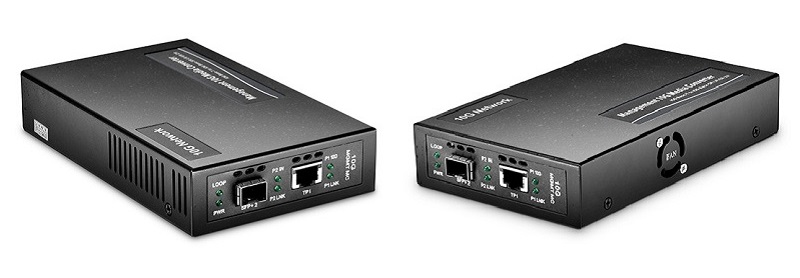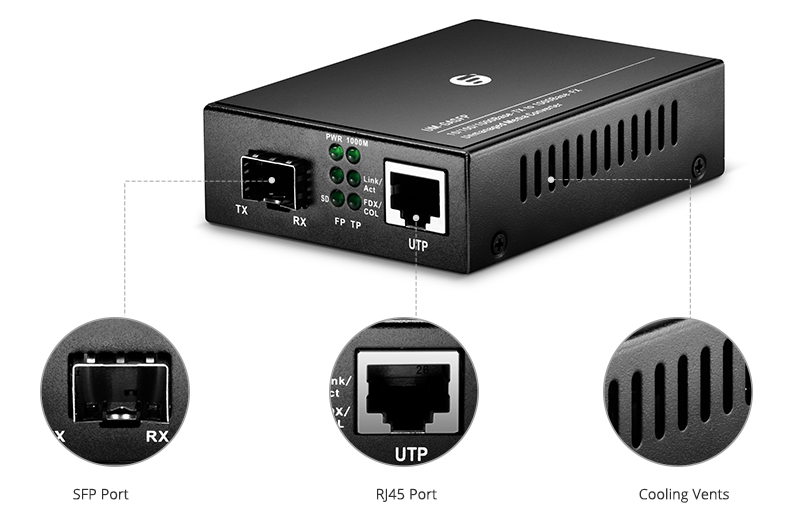Managed vs Unmanaged Media Converter: How to Choose?
Fiber media converter is now a widely-used device to connect two disparate cable types such as copper and fiber cables. Generally, media converters can be divided into two basic categories, that is managed media converter and unmanaged media converter. How to choose between managed and unmanaged media converter? Here, managed vs unmanaged media converter will be analyzed for references.
What Is Managed Media Converter?
Managed media converter supports carrier-grade network management, which is vitally important for mission-critical fully managed networks or networks dispersed over large areas to allow efficient control and maintenance. It has the ability to provide additional network monitoring, fault detection and remote configuration functionality, which used in conjunction with a managed switch that can add an additional security layer for LANs used to manage intellectual property or financial data. These converters can be easily deployed through a simple network management web interface or loaded into a chassis.

Figure 1: Standalone Media Converter.
What Is Unmanaged Media Converter?
Unmanaged media converter is the most inexpensive and convenient type for newbies. It features plug and play and can simply allow devices to communicate automatically in the network. However, unmanaged media converter does not provide the same level of monitoring, fault detection and configuration as managed media converters, which means when a network issue occurs, there is no way to access the media converter to see exactly what might be the cause. But this type of fiber media converter usually has DIP (dual in-line package) switch functions, through which basic configuration of duplex modes, auto-negotiation, and crossover can be achieved.

Figure 2: Unmanaged Media Converter.
Managed vs Unmanaged Media Converter: Which to Use?
Managed and unmanaged media converters both have their own features and functions, and they have different application environments.
Management Functions
Typically, managed media converters are equipped with remote Web/SNMP (Simple Network Management Protocol) interface, which enables network administrators to easily monitor and set up the converter, the transmission speed and duplex mode. To be specific, remote configuration reduces trips to edge equipment; performance monitoring provides warnings on potential problems; fault management proactively monitors for network problems and quickly isolates network faults; intuitive software interface simplifies provisioning of complex networks and services.
While, as for unmanaged media converter, the most important function is DIP switches mentioned above. DIP is used to change the operating mode of a device. In addition to the basic configurations mentioned earlier, unmanaged media converters with DIP switches can also configure other networking features such as remote fault indication, fault propagation, and loopback modes.
Security
Managed media converters support all authentication, authorization and accounting (AAA) security services used in corporate networks. To further protect IDs and passwords from “snooping” by someone in the network, managed media converters provide secure management sessions by supporting telnet. However, unmanaged media converter has very basic security, which is not as good as that of a managed one, due to the lack of SNMP for monitoring and management functions. This is partly why unmanaged media converters are avoided in many large data centers or enterprise networks requiring high security.
"Also check Security Support in FS Industrial Switch
Selection Suggestions
Managed fiber media converters are mostly suitable for those complex environments requiring a medium to large-scale deployment of Ethernet media converters. They are aimed at users who need a response time of milliseconds or to manage and troubleshoot the network remotely and securely, which allows network managers to reach optimal network performance and reliability. In these places, complete control of data, bandwidth and traffic is needed on any segment of the network.
While, the unmanaged media converters are mostly used to connect edge devices on network spurs, or on a small stand-alone network with only a few components. They are suitable for any network that needs to simplify the installation of home or small business network. In a word, due to advanced functions and performances, managed media converters are more widely used than unmanaged ones. But you need to choose them based on your specific demands.
| Item | Managed Media Converters | Unmanaged Media Converters |
|---|---|---|
| Features | Transparent transport and very low delay, SNMP, VLAN | Fixed configuration—doesn’t support any configuration interface or options |
| Functions | SNMP allows for remote troubleshooting of the network, Support ITUT prescribed DWDM/CWDM wavelength, Support Loopback test function | Plug and play with limited configuration like default QoS settings and VLAN, Auto negotiation function supports UTP ports to auto 10/100/1000M |
| Security | Provide protection of the data plane, control plane and management plane | No special security settings |
| Applications | Data center, large size enterprise networks | Small size business network, home, lab, conference rooms, etc. |
| Costs | More Costly | Less expensive |
Table 1: Managed Media Converter vs Unmanaged Media Converter.
Conclusion
Although managed media fiber converters are costlier than unmanaged media converters, they may be considered when better control and monitoring over network traffic is needed. But if you want to support a small company or campus with easy use and management, unmanaged media converter is good enough. No matter which type to choose, you have to consider your demands first.
You might be interested in
Email Address

-
PoE vs PoE+ vs PoE++ Switch: How to Choose?
Mar 16, 2023














